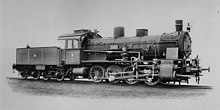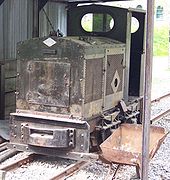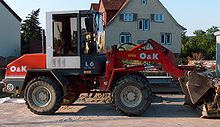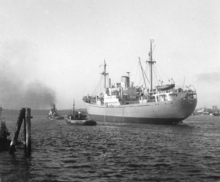Orenstein & Koppel
| Orenstein & Koppel AG
|
|
|---|---|
| legal form | Corporation |
| ISIN | DE0006865009 |
| founding | April 1, 1876 |
| resolution | 1999 |
| Reason for dissolution | Majority takeover by Fiat |
| Seat | Berlin , Germany |
| Branch | mechanical engineering |
| Website | www.oundka.com/de/ |
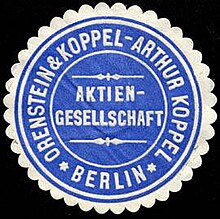
Orenstein & Koppel ( O&K for short ) was a German mechanical engineering company founded on April 1, 1876 and converted into a stock corporation in 1897 . O&K initially supplied light rail supplies such as lorries , tracks and switches and then manufactured, in addition to locomotives and wagons for freight and passenger traffic , a wide range of construction machinery , especially excavators of various designs, but also graders , dumpers and truck- mounted cranes . The company also produced escalators , gear , forklifts , compressors , track loaders , wheel loaders , dump trucks , U- and S-Bahn - cars , buses , tractors , road rollers and cargo ships , passenger ships , shipboard cranes and ship unloading. The company had various production sites in Germany , a high export share and a global network of branches. It was dissolved in 1999.
history
Beginning in Schlachtensee near Berlin
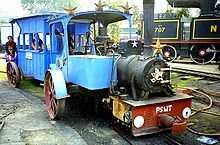
The company was founded on April 1, 1876 by Benno Orenstein and Arthur Koppel as a general partnership (oHG) in Schlachtensee near Berlin. It was originally a pure trading company for light railways that resold railroad tracks , tilting trucks and the like.
Benno Orenstein brought in 3,000 marks as a loan from an uncle in 1876 , Arthur Koppel, as the former authorized signatory of the GE Dellschau iron shop, 15,000 marks. Regular trading began on May 15 of the founding year. The company initially developed relatively slowly, and in 1885 the two partners separated by mutual agreement. They divided their market abroad and inland for five years, and Koppel founded the Arthur Koppel company , which remained more successful abroad.
In the meantime, Orenstein involved two other merchants and his brother Max Orenstein, and in 1886 acquired the Tempelhofer Ufer 23-24 location in Berlin. In a few years around 1895, O&K branches were established in Dorstfeld (near Dortmund ), Prague and Budapest . The company also set up branches in Buenos Aires , Durban and Johannesburg , Java and Calcutta . In 1897, the company was converted with Dresdner Bank as the house bank into the stock corporation for field and small railroad needs, formerly Orenstein & Koppel . This was followed by factories near Potsdam and Warsaw , as well as in Spandau , and the production of vehicles for standard gauge from 1900.
In 1905 O&K and Arthur Koppel AG merged their sales and distribution , and after Koppel's death in 1908 they were merged in 1909 to form Orenstein & Koppel - Arthur Koppel AG .
In the early 1910s, O&K was a model for manufacturing technology . In 1911, an interest group was agreed with the Lübeck mechanical engineering company , which also manufactured construction vehicles.
Around 1911, a syndicate with the French company Société Nouvelle des Établissements Decauville Ainé was also concluded . The twenty-year contract was aimed at dividing the sales areas. Orenstein & Koppel took over the Belgian Decauville plant in Val-Saint-Lambert and left its plant in Fives (northern France) to Decauville .
In 1913, the company celebrated the completion of its 5,000th locomotive. By 1913 the company had a dozen factories and nearly a hundred offices worldwide; almost 15,000 people were employed. The main administration building in Berlin, completed in 1914, is evidence of this economic boom .
time of the nationalsocialism
From the 1930s onwards, standard-gauge rail vehicles were also built in larger numbers in addition to field railways , mainly shunting diesel locomotives and the standard steam locomotives of the series 44 , 50 and 64 for the Deutsche Reichsbahn . Cable excavators and bucket wheel excavators were manufactured in Spandau .
In 1933 the Dresdner Bank sent a National Socialist and old comrade Hermann Göring as a member of the supervisory board of O&K, who operated the so-called Aryanization . He immediately organized a " conformity agreement " that gave him the right to vote for the 16% of the shares that belonged to the Jewish Orenstein family. In August 1933, the shareholders' meeting resolved to reduce the capital by around 45%. In 1935, the chairman of the board, Alfred Orenstein, was arrested, resigned and went into exile in Johannesburg , where he worked for the local branch of O&K in South Africa until October 1938 . In February 1940 the company experienced a capital increase and called itself Maschinenbau und Bahnbedarf Aktiengesellschaft, formerly Orenstein & Koppel . The abbreviation O&K was replaced by MBA . From November 1940 the company no longer named the Jewish founders Orenstein and Koppel, and at the turn of the year Hoesch AG took over the majority of the shares. The company also used forced labor.
A great-granddaughter of Benno Orenstein and a federal judge in the USA learned of her Jewish origin in 1993 and sued for compensation in the first decade of the 21st century. Her grandmother, who inherited a quarter of Benno Orenstein's shares, asked Deutsche Bank for a list of her share assets in 1950 , but received no answer, and there is only one receipt of payment for almost RM 38,000 for shares in Alfred Orenstein.
post war period
In the west of Germany, the company traded under the name "Orenstein & Koppel AG" again from 1949; after the merger with Lübecker Maschinenbau AG (LMAG) in 1950 the name was changed to "Orenstein-Koppel and Lübecker Maschinenbau AG". The seat of the corporation was Berlin. After the Berlin Wall was built in 1961, however, the head office was moved to Dortmund; she moved into a newly constructed building on the Dortmund factory site. The company grew steadily until the mid-1970s.
In 1972 O&K produced in five plants: Berlin (West), Dortmund, Hagen, Hattingen / Ruhr and Lübeck, had a central spare parts service in Bochum, 24 branches and sales offices in the Federal Republic as well as agencies in all five continents. In the same year the company had 8,550 employees, the turnover was 622 million DM, the export share was 31%.
1986 O&K acquired the majority of the shares in FAUN-Werke , whose construction machinery production in Lauf an der Pegnitz , Kissing and Batavia (USA) was integrated into O&K Construction Machinery and Extraction Technology on August 1, 1986 . The takeover was of great importance for O&K, as suitable dump trucks and large wheel loaders could now be offered in addition to the large hydraulic excavators that had been manufactured so far. After the takeover, O&K therefore continued the production of dump trucks, wheel loaders and graders in the three plants. The production of the Faun hydraulic excavators, on the other hand, was discontinued because O&K already had enough of its own models to offer. In 1990, O & K sold the plant in running that at this time in the production of mobile cranes had dedicated to the Japanese crane manufacturer Tadano . In addition, in 1992 O&K parted with wheel loader production overseas by shutting down production at the US plant in Batavia.
The decline of O&K continued in the late 1990s. In 1996 the manufacture of escalators went to the KONE Corporation . On April 1, 1998, the production of heavy hydraulic excavators for open pit mining was also given up. The new owner was the US company Terex (since February 19, 2010 Bucyrus International and from July 8, 2011 Caterpillar ). Due to ongoing losses at O&K, Hoesch-Krupp finally sold the remnants of the construction machinery division to the Fiat subsidiary New Holland ( CNH Global from 1999 ) at the end of 1998 , and the Italian transmission manufacturer Carraro took over the axle and transmission manufacturing in Hattingen in 2000 .
Construction machinery production in Germany was gradually reduced after the sale to New Holland and relocated to Italy. In 1999, production at the Kissingen plant was shut down. The Spandau site was initially not closed, however, not least due to massive protests by the remaining 500 employees. Gradually, however, CNH also relocated this production to Italy, so that in 2015 there were only just under 100 employees in sales.
Locations
Drewitz plant / Neuendorf plant / Babelsberg plant
On April 1, 1899 , the subsidiary Märkische Lokomotivfabrik Orenstein & Koppel oHG , which was founded especially for this purpose, opened a branch with an extensive boiler forging facility near Drewitz train station . Officially, it was not in Drewitz , but in the neighboring district of Neuendorf , which later became part of Babelsberg . From 1938 the locomotive factory was referred to as the "Babelsberg Factory".
There were later u. a. Standard locomotives of the series 41 , 44 , 50 and 64 as well as the war locomotives of the series 52 were built.
After the Second World War, the production of steam locomotive boilers was resumed in 1946 and the first post-war locomotive was delivered a year later. On March 18, 1948, the company was converted into a state-owned company under the umbrella of LOWA and thus renamed VEB LOWA Lokomotivbau Karl Marx Babelsberg , or LKM for short. The LKM mainly took on the construction of diesel locomotives for the GDR, including large diesel locomotives such as the V 180 . The last diesel locomotive was delivered in 1976 after a part of the diesel locomotive production had been transferred to VEB Lokomotivbau Elektrotechnische Werke "Hans Beimler" (LEW) in Hennigsdorf in 1964 . The company switched the product profile from air conditioning to mechanical engineering. In 1990 the mechanical engineering company Karl Marx Babelsberg was converted into a GmbH by the Treuhandanstalt and then liquidated by 1992, although there were serious development offers. Today there is an industrial park on the site.
Spandau plant
The wagon and switch construction company of O&K in Spandau later also manufactured excavators.
After the turn of the century, O&K built bucket chain excavators for the first time , initially with wooden conveying containers and from 1904 "made entirely of iron", powered by steam engines or alcohol engines. In 1908, O&K developed a backhoe that ran on rails for work in heavy soils. In 1922 a steam powered backhoe was built on its own crawler track . From 1926 diesel engines were installed in the excavators instead of steam engines .
Dessau plant
In 1930, O&K took over Dessauer Waggonfabrik AG , which then - as in the Spandau factory - manufactured underground and S-Bahn cars.
Although the plant survived all bombing attacks, after a fire in the administration building and dismantling, no more locomotives were built there.
Nordhausen plant
In Nordhausen , Montania AG, formerly Gerlach & König, had been building combustion engine locomotives since 1907 , which were sold through O&K. In 1912 or 1916 this company was taken over by O&K and continued as "Werk Nordhausen".
The seizure of all locomotives by the Heeresfeldbahn during World War I, the provisions of the Versailles Treaty and the elimination of export markets hit the plant so badly that production had to be stopped for three months at the end of 1925. A few years later, however, the plant was able to recover and produced 5299 locomotives by 1935, and a total of 9371 units by the last delivery in January 1942. At that time, locomotive construction, including 421 locomotives that had already started, was relocated to Prague. During the Second World War 400 class 52 war locomotives were built by O & K / MBA - it is unclear, however, whether this happened in the Babelsberg or Nordhausen works. After the end of the war, locomotive construction was not resumed in Nordhausen.
In the GDR , VEB Schwermaschinenbau Nordhausen manufactured rope excavators under the “NOBAS” brand in the expropriated plant .
Dortmund-Dorstfeld plant
The factory in Dortmund- Dorstfeld had around 2000 employees in peak years. From 1949 onwards, the main focus of production was on wagon construction and construction machinery, especially excavators. In 1961, O&K produced fully hydraulic excavators in series for the first time in Europe. More than 55,000 hydraulic excavators have been manufactured to date, including more than 700 devices with an operating weight of over 100 tons, including the largest hydraulic excavator in the world, the RH 400 (since 2012 CAT 6090) with an operating weight of 980 tons, an engine output of 3280 kilowatts (4400 hp) and one Shovel capacity of almost 45 cubic meters.
Light rail locomotives were again built for railways until the 1960s. Standard gauge diesel locomotives were built in several series, including individual vehicles on bogies in the 1970s . The focus was on shunting locomotives, for example the types O&K RL8 , O&K MC 700 N , O&K MB 125 N , O&K MC14N and O&K MV 3 . For 1968 the annual report showed that in the diesel locomotive product segment more than 12,000 different series were in use worldwide. Locomotive production was stopped in 1981.
The wagon construction ( freight wagons ) took up part of the Dortmund plant . Compressors were also manufactured until the late 1960s . Another part of the Dortmund plant produced construction machinery, mainly excavators (wheel and chain drives).
The construction machines in particular were designed for various operating conditions, including extreme climates, and delivered to all parts of the world. The export share of some products was around 80% in some cases.
Since the early 1980s, the plant has come under stiff international competition, especially from US and Japanese companies in the construction machinery sector. There was a continuous reduction in production and a sharp decline in the number of employees. The wagon construction was finally stopped completely. Since April 1, 1998, the production of heavy hydraulic excavators for open-cast mining ("O&K Mining Dortmund") has been integrated into the Terex Group. On February 19, 2010 Terex sold its "mining" division to Bucyrus , the O&K excavators were sold under the Bucyrus brand, but the O&K model designation. At the end of 2010, Caterpillar swallowed the entire Bucyrus group.
The brands O&K and Bucyrus have been history since the beginning of July 2011 . The rest of O & K's construction machinery production went into the CNH group. The entrepreneur Stüttem registered the European trademark rights for the brand names “O&K Mining” and “Orenstein & Koppel” and the logo with the diamond for his IBB GmbH and MineParts GmbH in October 2011 after a legal dispute with Bucyrus / Caterpillar.
Lübeck plant
The Lübeck plant was an important part of the O&K group for decades. In addition to shipbuilding in its own shipyard , the plant produced opencast mining equipment, primarily for lignite mining . After the O&K parent company Hoesch AG was initially taken over by Friedrich Krupp AG , which later merged with Thyssen to form ThyssenKrupp AG , this initially led to the integration of the Lübeck activities into the plant construction group , followed by the outsourcing.
The Lübeck plant specialized in ship excavators, and large machine construction and the manufacture of wind turbines were also part of the production program. The Lübeck machine park with very large machines for mechanical processing was remarkable. A well-known dredger is the Nordsee suction dredger operated by the Wasserstraßen- und Schifffahrtsamt Weser-Jade-Nordsee .
Bochum plant
The Arthur Koppel AG plant, which was built in Bochum around 1890, was located in the triangle between Bessemerstraße, Wörthstraße (today Ursulastraße) and the track of the old Bochum main station. The factory came to Orenstein & Koppel AG through the merger in 1909 . Mainly field and small railroad cars as well as narrow-gauge special cars were manufactured here . The plant was badly damaged in the Second World War and was ultimately only used as a central spare parts store. Today it is used as "Henry Bessemer Park", among other things as a training facility for street art (OPENSPACE).
Hattingen plant
The plant in Hattingen was divided into two parts. In one part of the factory, escalators (escalators) were built for decades under O&K direction and exported worldwide; this escalator production was sold to KONE in 1996 , which in turn gave up the Hattingen location in 2005. Gearboxes were and are produced in the immediately adjacent part of the factory.
Kissing plant
With the takeover of the FAUN-Frisch construction machinery division in 1986, O&K also acquired the plant in Kissing, which was located south of the Kissingen train station and adjoined the Augsburg-Munich railway line to the west and Bundesstraße 2 to the east. It was opened in 1936 and gradually expanded to a size of 14 hectares after the Second World War. O&K manufactured wheel loaders and graders there until they were sold to New Holland in 1998. The new owner finally shut down construction machinery production in 1999. Subsequently, the conversion into a commercial center took place. The building stock has remained almost unchanged until today (February 2020).
More locations
For several years, heavy forklifts were manufactured in a factory in Hagen .
literature
- Carsten Bengs: Orenstein & Koppel - 125 years of construction machinery, locomotives, tractors . Verlag Podszun, Brilon 2002, ISBN 3-86133-281-7 .
- Aktiengesellschaft für Feld- und Kleinbahnbedarf (formerly Orenstein & Koppel): pocket notebook for the building trade and the stone industry. 1904/1905.
- Roland Bude, Klaus Fricke, Martin Murray: O&K steam locomotives. Delivery directory 1892–1945. Railroadiana Verlag, Buschhoven 1978, ISBN 3-921894-00-X .
- Horst Kieber: Industrial site - Casseler-Strasse 30 c - 90 years of mechanical engineering in Nordhausen. In: Contributions to local history from the city and district of Nordhausen. Issue 20/1995.
- O&K delivery documents for the Nordhausen plant . Dortmund, Berlin plant, O&K agency in Amsterdam.
- Bodo Schulz, Michael Krolop: The private and industrial railways in Berlin (West). Verlag Kersting, Niederkassel-Mondorf 1989, ISBN 3-925250-06-9 .
- LKM delivery documents in the Brandenburg State Main Archive in Potsdam
- Information from the companies O&K Mining, Dortmund, Bombardier Transportation Berlin and Adtranz DaimlerChrysler Rail Systems, Berlin.
- Matthias Heisig: Feldbahnen on the Ringbahn - Orenstein and Koppel. In: From iron to pralines. Tempelhof and its industry. Exhibition catalog. Berlin 2000.
- Hitchhikers scoreboard . March 17, 1930.
- A. Welte: 100 years of Orenstein & Koppel Lübeck plant , Hamburg: Schiffahrts-Druckerei Schroedter & Hauer, 1973 (special print from "Hansa", issue 7/73).
Web links
- werkbahn.de
- Historic O&K machines ( Memento from October 13, 2007 in the Internet Archive )
- AG Märkische Kleinbahn RL 7 No. 20473 at AG Märkische Kleinbahn
- Directory of all O&K steam locomotives preserved worldwide
- Early documents and newspaper articles on Orenstein & Koppel in the 20th century press kit of the ZBW - Leibniz Information Center for Economics .
- chronology
Individual evidence
- ↑ a b O&K: “Tradition in Innovation”. Snowcrest, accessed September 5, 2017 .
- ↑ a b History - Over 130 years of experience. Bonfiglioli Riduttori , February 18, 2018, archived from the original on September 5, 2017 ; accessed on September 5, 2017 .
- ↑ Orenstein and Koppel at werkbahn.de , accessed on June 10, 2014.
- ↑ a b c d Orenstein, Benno . In: New German Biography . tape 19 . Duncker & Humblot, 1999, p. 587/588 ( deutsche-biographie.de [accessed June 9, 2014]).
- ↑ The engineer Max Orenstein founded the Märkische Lokomotiv-Fabrik in Schlachtensee in 1890 .
- ^ The organization of normalization at Orenstein & Koppel - Arthur Koppel A.-G., Berlin . In: Workshop technology . No. 1 . Verlag von Julius Springer, Berlin 1913, ISBN 978-3-662-24011-3 ( excerpt [accessed on June 9, 2014] special edition 2013, foreword by Georg Schlesinger ). ( Page no longer available , search in web archives ) Info: The link was automatically marked as defective. Please check the link according to the instructions and then remove this notice.
- ↑ Société Anonyme Décauville at albert-gieseler.de, accessed on April 30, 2019
- ^ Orenstein & Koppel - Arthur Koppel AG (Ed.): Memorandum on the occasion of the completion of the 5000th locomotive. With a look back at the development of Orenstein & Koppel - Arthur Koppel Aktiengesellschaft . Berlin 1913.
- ↑ a b c Judgment of April 22, 2009 - 8 C 5.08. In: Federal Administrative Court . Retrieved June 9, 2014 .
- ^ Alfred Orenstein (1885-1969). (No longer available online.) In: Berlin Theme Year 2013 - Destroyed Diversity. State of Berlin, archived from the original on July 14, 2014 ; Retrieved June 9, 2014 .
- ↑ Tanja von Fransecky: Forced Labor in the Berlin Metal Industry 1939 to 1945. Otto Brenner Foundation, accessed on November 30, 2019 .
- ↑ Holocaust suit raises foreign policy issue. In: Chicago Tribune . July 7, 2003, accessed June 9, 2014 .
- ↑ Ungaro Benages v. Dresdner Bank AG. In: FindLaw. Thomson Reuters , August 3, 2004, accessed June 9, 2014 .
- ^ Moody's International Manual . Moody's Investors Service, Mergent FIS, 1995, p. 3275 .
- ^ A b Keith Haddock: The Earthmover Encyclopedia . MotorBooks International, 2007, ISBN 978-1-61059-209-3 , pp. 101 .
- ↑ Ulf Böge: Jahrbuch Baumaschinen 2020. Podszun-Verlag, 2019, ISBN 978-3-86133-934-2 , page 107.
- ↑ Batavia Manufacturer to close within 2 months. The Buffalo News , January 8, 1992, accessed December 29, 2018 .
- ↑ Caterpillar completes acquisition of Bucyrus. (PDF; 52 kB) Caterpillar, archived from the original on September 29, 2011 ; accessed on June 28, 2014 .
- ↑ Orenstein & Koppel is sold to a Fiat subsidiary. In: Der Tagesspiegel . November 24, 1998, accessed June 7, 2014 .
- ↑ O&K works council receives email from Italy. In: Westdeutsche Allgemeine Zeitung . November 26, 2009, accessed February 7, 2020 .
- ↑ Daily to the mailbox. In: Berliner Zeitung . June 7, 2007, accessed June 7, 2014 .
- ↑ Ulf Böge: Jahrbuch Baumaschinen 2020. Podszun-Verlag, 2019, ISBN 978-3-86133-934-2 , page 112.
- ↑ Sold for stupid . In: Der Spiegel . No. 14 , 1992, pp. 145-147 ( online ).
- ^ The acquisition of the majority of the Dessau wagon factory by Orenstein & Koppel. As the O&K A.-G. announces in Berlin that the company has acquired around 75% of the share capital of 2 million marks. O&K hopes to significantly promote the production of the Dessau company through appropriate financing. In: Anhalter Anzeiger of March 17, 1930.
- ↑ New Generation (last program) on rangierdiesel.de , accessed on August 7, 2013.
- ↑ A. Welte: 100 years of Orenstein & Koppel Lübeck plant. Hamburg 1973, p. 3 ff.
- ^ F. Kemper: The Origins of Orenstein & Koppel. on irsociety.com
- ^ Address book of the city of Bochum 1938 , section "Chronicle of Bochum Companies"
- ^ Franz Peine (Ed.): That was Bochum. Ferdinand Kamp, Bochum 1981, ISBN 3-592-77030-6 .
- ↑ Urbanatix
- ↑ Ulf Böge: Yearbook Construction Machinery 2020. Podszun-Verlag, 2019, ISBN 978-3-86133-934-2 , page 81.





